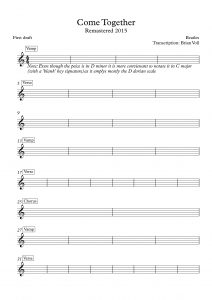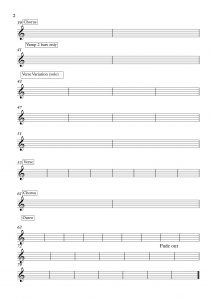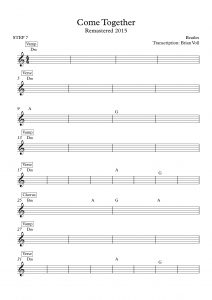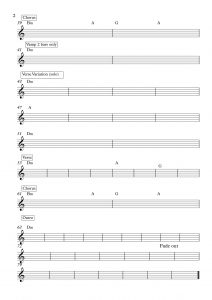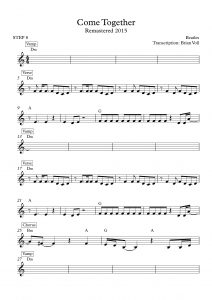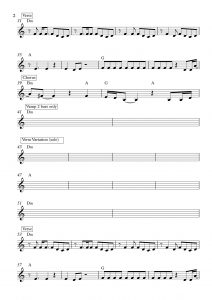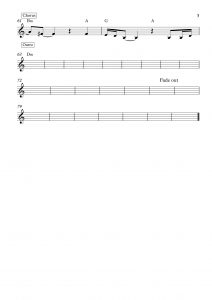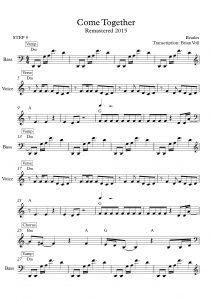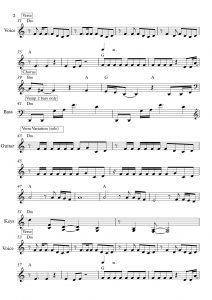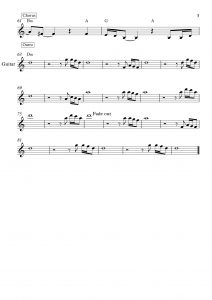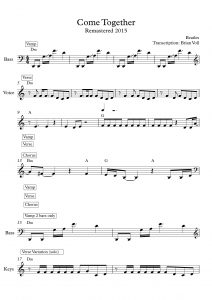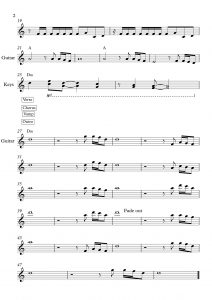Making a lead sheet
Lesson goal: be able to listen to a piece of music and make a chart with the melody, chords and anything else significant.
I hope that this lesson will at least give you a glimpse of what it is like to learn a song by ear and what are the steps towards making a reliable chart.
Form
Do you ever wonder how some musicians can play hundreds of songs from memory? And not only the melody from the chorus, but every other section of the song and the chords too? Well one thing that helps a lot is a good understanding of popular forms in music. A good musician when learning a song will listen to it one time and will remember everything that sounded familiar. What I mean is that they will pick out certain repeating melodies or chord changes and will start trying to compare them with other songs that they have heard. One thing that we can begin to compare right away is form. Form is the organization of large sections of music. So in a pop song, form describes the organization of the verse, chorus, bridge, breakdown, solo, and whatever other section that song may have. Form is also used to describe specific chord progressions like the 12-bar blues, or rhythm changes for example. Try this homework assignment to see where you are at with your understanding of form:
Assignment 6.1:
Do this assignment right now and don’t spend more than 40 minutes on it. Some pieces you won’t even need to listen to the whole song – only a couple times through the form. (there are no ‘tricky’ ones in this sense)
Listen to the following 7 songs and group them into 3 form classes:
12-bar blues (12 bar long form)
rhythm changes (type of 32-bar form)(32 bar long form laid out as AABA (8bars each))
verse chorus form (any number of bars, chorus and verses can be made longer or shorter)
The Blues Brothers – Sweet Home Chicago
Joshua Redman – Moose the Mooche
Pharrell Williams – Happy
Hoyt Curtain – Flintstones Theme Song (ignore 0.00-0.09)
Hoyt Curtain – Flintstones Theme Song
Jimi Hendrix – Foxy Lady
The White Stripes – Ball and Biscuit
The White Stripes – Ball and Biscuit
B.B. King – The Thrill Is Gone
Check how you did right now – Answers
How did you do? When considering the form of a piece of music it is important to first look macroscopically at the piece as a whole. How many sections are there in the piece? This can vary drastically among styles. For example, a blues song may have the same 12 bars repeated with the only notable changes being who takes the role of the soloist, where as a classical piano sonata will be about 20 minutes long containing 3 movements in which each movement has its own form – often being as complicated as the Sonata Allegro form:
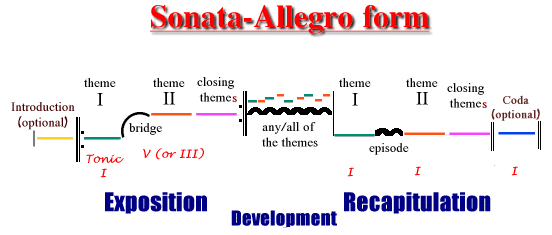
As a side note, when I say the sections of a piece of music, what generally constitutes a different section is a different chord progression. However, there are examples of songs that have the same chord progression but have verses and choruses like Eminem – Love The Way You Lie ft. Rihanna |Gm |Eb |Bb |F |. In these cases the music will change in a different way (change in orchestration, groove/feel, melody etc…) that will usually be obvious.
So the first thing that you want to do when you are making a chart is listen to the entire piece and determine the form. Please note that it is not so important which part is the chorus and which part the verse etc., that will come with experience. For now if you are not sure you can label sections A, B, C, D…
Here is an example:
Demo 6.1 Form
Assignment 6.2: Write down the form to the following pieces of music:
Bela Fleck – Mazurka in F-Sharp Minor (Chopin) (Actually in E minor)
John Coltraine – Woody’n you
Jimi Hendrix – Foxy Lady
So now that you have had some experience with finding the form of your songs it will be much easier for us to make a chart.
Making a chart
- Title, date, composer/artist/version, your name if you would like, original key if you are learning it in a new key
- Listen to the song and on a separate piece of paper jot down the form. Check what you have jotted down is correct by listening to the song. You can use technology to speed up the song and save time if you can handle the faster tempo.
- Determine the time signature.
- Determine how many bars are in each section
- Insert the correct number of empty bars and labels for each section. Try to lay it out in the clearest possible manner. It helps to keep 4 bars to a system if possible and to make breaks for each new section. For now do not use any repeat directions/symbols (D.C. al Fine, D.S. al Coda, To Coda, jump to etc…) write the chart out straight through. For those of you writing by hand I know this can be tedious so you can look at step 10) right away.
- Determine the key.
- Write out the chords for the entire song. I recommend working section by section.
- Write the main melody for the entire song. Sometimes there will be slight variations between repeated sections of the song. If the melody is significantly different between these sections it is worth writing it out both times. If it is only slightly different it is acceptable (although not preferred) to use the first occurrence of the section every time.
- Write out anything else that you believe is important: a specific bassline, a specific guitar riff, a specific unison line that the whole band plays together, any shots, pushes or kicks, even dynamics. You may need to add more staves for more instruments.
- Reduce the size of your chart by either:
⦁ using repeat directions and symbols (D.C. al Fine, D.S. al Coda, To Coda, jump to etc…)
⦁ using section labels to replace repeated sections (make sure they are big enough)
⦁ writing out each section of the piece and then writing the form above. (ABABCA(solo)BD for example)
⦁ any combination of the above - play along to the song (it may help to slow the song down) and check your chart for accuracy.
Steps 7,8,9 can be done in any order and can be omitted based on your goals with the transcription. Here are a couple examples:
- If the song uses a very common form like the 12 bar blues, it may make sense for you to only do steps 1 – 6. You jot down how many choruses (yes, each run through the 12-bar blues form is called a chorus – confusing) there are and when there is singing, when there is a soloist and the key of the song. Maybe you even jot down a specific guitar riff that repeats over the blues.
- If you play flute and you will not do a solo on the particular piece maybe it only makes sense for you to write a chart with the form and the melody that the flute plays during each section. i.e. no step 7 and 8
- if you are interested in doing a solo piano cover of the piece and it starts out with just the bassline it would make sense to include that bassline in your transcription and also to do steps 7 and 8
Remember that the more interested you are the more worthwhile the process. So try to pick songs that you are interested in and try to additionally transcribe what you find interesting in the songs, be it the bassline, guitar riffs, drum groove, vocal melody.
An example with The Beatles – Come Together
A couple considerations
| Software | Handwritten | ||
| Pros | Cons | Pros | Cons |
| Clean professional looking charts | Time and energy wasted due to unfamiliarity with the software (notation software is not user friendly) | Usually faster | Mistakes can be more difficult to fix |
| Ability to change the key, clef, octave, instrument – almost anything | Need to be at a computer | Easier to make personal notes /markings on the chart | Can be difficult to read for you and others |
| Copy and paste possibilities | Again, notation software is not user friendly | great for small scale transcriptions (small passages, chord progressions) | only exists as a physical sheet of paper (unless scanned) |
| Midi easily extracted | Need to print or transfer to a tablet to read | ||
I know it can seem tedious and time consuming but having good charts is important. Whilst making a chart you are learning and subconsciously memorizing the song. Charts can also be saved and accessed later!
Hence one more convincing scenario:
You play keyboard in a band that plays 80’s music. The band has a couple gigs every month and you now know the material really well. The band folds. 2 years later they call you back up and say they found a new guitarist and they have a gig booked. You have forgotten all the songs and you need to learn them again. Had you charts for the songs you would need only have a quick look at your charts and you would be ready for the gig.
As we will see in Lesson 8, there will be times in which notating a transcription is not necessary. That is, learning a piece by ear and then playing it on your instrument can at times prove to be more in tune with your goals and be more beneficial to you as a musician. However, notating is by definition part of transcription and it is a skill that you should possess regardless of whether you will use it extensively – chances are you will.
Assignment 6.3:
- Make a chord chart for 2 out of three of: Beyoncé – If I Were A Boy, When I come around – Greenday, Plain White T’s – Hey There Delilah. (steps 1 – 7)
- Transcribe either
i) Flute in Jethro Tull – Thick as a Brick (first 3 minutes only) (steps 1-8 but not 7)
or
ii) the remainder of the oboe part in Renato Braz – Anabela (steps 1-8 and again you can omit step 7) – We already looked at this piece in Lesson 3 - Pretend you are doing a solo piano cover of Red Hot Chili Peppers – Californication. Write out a complete chart including:
i) bass and guitar intro 0.00-0.24 – try to listen seperately to both the bass and the lead guitar and notate them each on their own staff.
ii) Vocal melody (first verse 0.24-0.39, first prechorus 1.04-1.33, first chorus 1.33-1.43)
BONUS CHALLENGE: iii) Guitar solo 3.22 – 4.02 – be careful of the bent notes (if you are not sure what to do we will talk about it next lesson)
